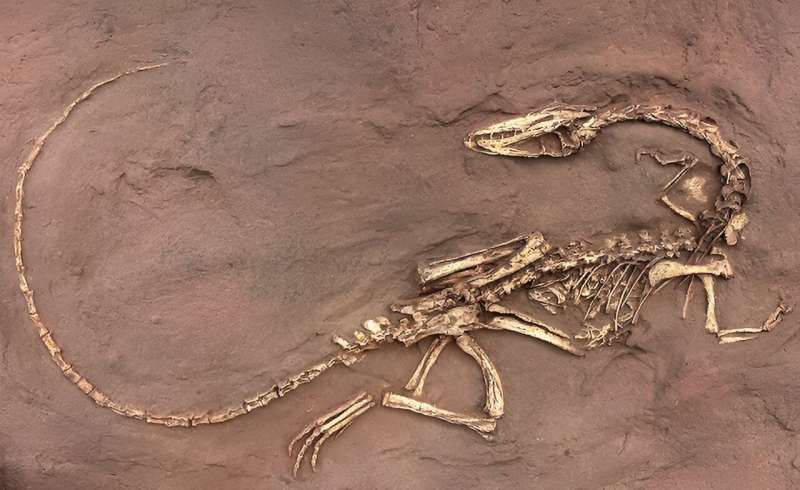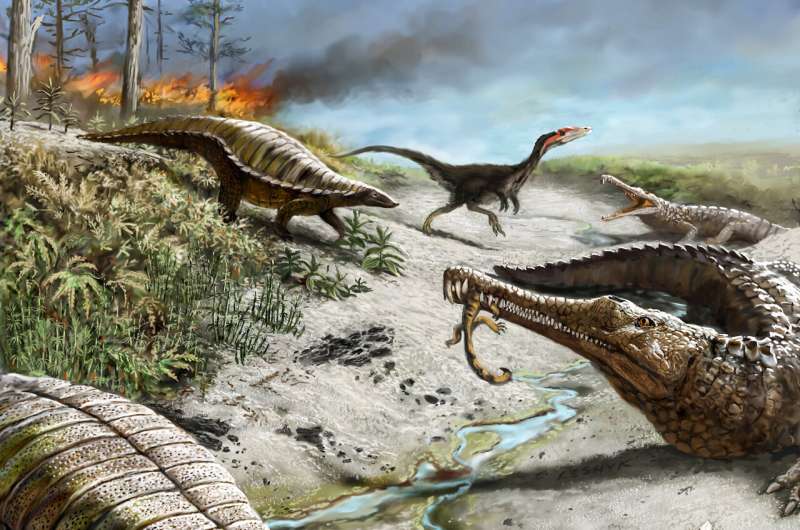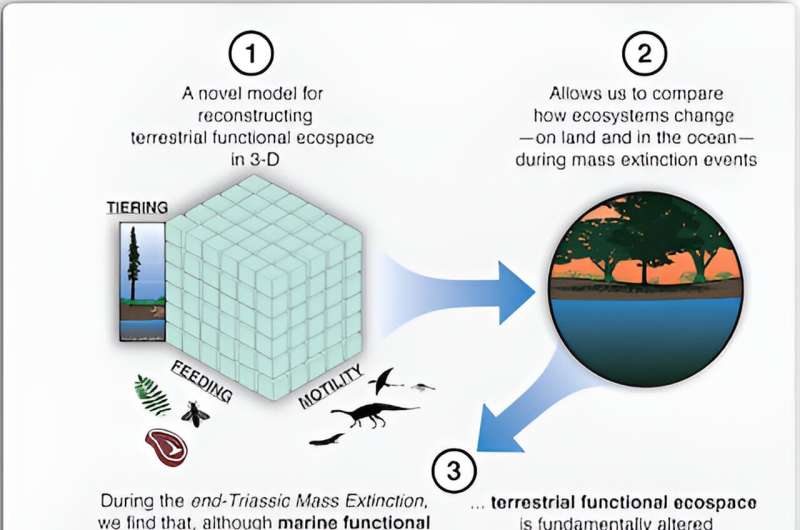This article has been reviewed according to Science X's editorial process and policies. Editors have highlighted the following attributes while ensuring the content's credibility:
fact-checked
peer-reviewed publication
trusted source
proofread
Research pieces ancient ecosystems together to reveal new details about the end-Triassic mass extinction

Startling new insights into the catastrophic impact of one of the most devastating events in Earth's history have been revealed by a team led by researchers with the USC Dornsife College of Letters, Arts and Sciences. More than deepening our understanding of the end-Triassic mass extinction, their findings offer critical lessons for today's environmental challenges.
About 200 million years ago, Earth experienced its fourth major mass extinction event. Triggered by a dramatic rise in greenhouse gases due to volcanic activity, the event led to rapid global warming and a significant shift in the planet's biosphere, ending the Triassic period and launching the Jurassic. Many scientists now believe Earth is in the midst of another mass extinction, driven in large part by similar climate changes.
Earth scientists at USC Dornsife took a unique approach to analyzing the impact of this extinction event on both ocean and land ecosystems, using a novel "ecospace framework" method that categorizes animals beyond just their species. It accounts for ecological roles and behaviors—from flying or swimming predators to grazing herbivores and from ocean seafloor invertebrates to soil-dwelling animals on land.
"We wanted to understand not just who survived and who didn't, but how the roles that different species played in the ecosystem changed," said David Bottjer, professor of Earth sciences, biological sciences and environmental studies at USC Dornsife and a study senior author. "This approach helps us see the broader, interconnected ecological picture."
The study, a collaboration between students and faculty at USC Dornsife and the Natural History Museum of Los Angeles County, was published in Proceedings of Royal Society B.
Sea life suffered, but not as much as land animals
The research revealed a stark difference in the impact on marine and terrestrial ecosystems. While both realms suffered greatly, the findings suggest that land-based ecosystems were hit harder and experienced more prolonged instability.
In the oceans, nearly 71% of categories of species, called genera, vanished. Surprisingly, despite this massive loss, the overall structure of marine ecosystems showed resilience. Predators like sharks, mollusks known as ammonites and filter feeders like sponges and brachiopods, though severely affected, eventually bounced back.

On land, the scenario proved much bleaker. A staggering 96% of terrestrial genera went extinct, dramatically reshaping the landscape of life on Earth. Large herbivores like early dinosaurs and various small predators suffered greatly, with significant changes in their populations and roles within the ecosystem.
"This contrast between land and sea tells us about the different ways ecosystems respond to catastrophic events," said co-lead author Alison Cribb, who earned her Ph.D. in geological sciences at USC Dornsife this year and is now at University of Southampton in the U.K. "It also raises important questions about the interplay of biodiversity and ecological resilience."
Climate change clues from ancient catastrophe
The study's findings spark more than just historical interest—they carry significant implications for our current environmental challenges. "Understanding past mass extinctions helps us to predict and possibly soften the impacts of current and future environmental crises," said co-lead author Kiersten Formoso, who is finishing her doctoral studies in vertebrate paleobiology at USC Dornsife and will soon move to a position at Rutgers University.
The parallels between the rapid global warming of the end-Triassic and today's climate change are particularly striking. "We're seeing similar patterns now—rapid climate change, loss of biodiversity. Learning how ecosystems responded in the past can inform our conservation efforts today," Bottjer said.
The research also provides a rare window into the world as it existed over 200 million years ago, he added. "It's like a time machine, giving us a glimpse of life during a period of profound change."
The study's ecospace framework, with its focus on functional roles, offers a fresh perspective on ancient life, according to Frank Corsetti, professor of Earth sciences and chair of USC Dornsife's Department of Earth Sciences. "It's not just about identifying fossils," he said. "It's about piecing together the puzzle of ancient ecosystems and how they functioned."
Future ventures will delve into the past's lessons
As they plan further research, the scientists aim to explore how different species and ecosystems recovered after the extinction, and how these ancient events can parallel current biodiversity loss due to climate change.

Future studies are also planned to examine changes in ecospace dynamics across other periods of profound environmental change in deep time.
"We've just scratched the surface," said Cribb. "There's so much more to learn about how life on Earth responds to extreme changes, and this new ecospace framework offers great potential for helping us do that."
Pandemic sparks unique, collaborative project
The study was conceived, and much of the work done, during the COVID-19 pandemic, when restrictions on many other types of research were in place, said Bottjer. "This produced unique conditions that fostered and led to development and completion of this research involving individuals with expertise across a broad variety of paleobiological fields, from microbes to invertebrates to vertebrates, in marine and terrestrial environments, with everyone working together towards one goal," he said.
Bottjer said Cribb and Formoso initially devised the collaboration with his and Corsetti's supervision and essential contributions from the study's other co-authors.
More information: Alison T. Cribb et al, Contrasting terrestrial and marine ecospace dynamics after the end-Triassic mass extinction event, Proceedings of the Royal Society B: Biological Sciences (2023). DOI: 10.1098/rspb.2023.2232
Journal information: Proceedings of the Royal Society B
Provided by University of Southern California


















